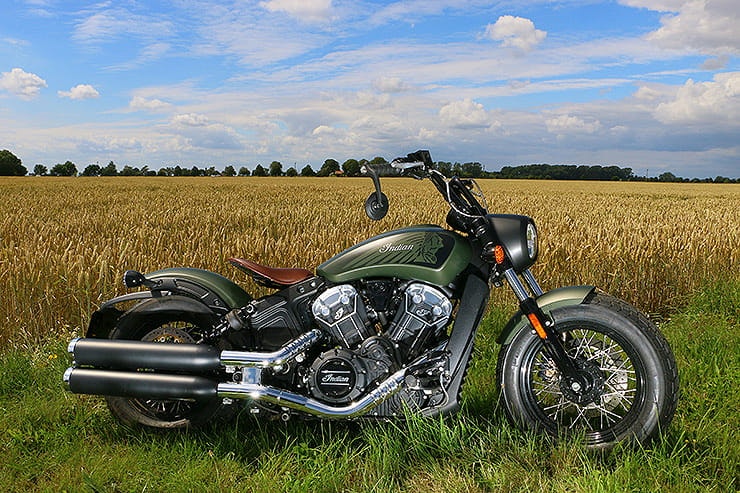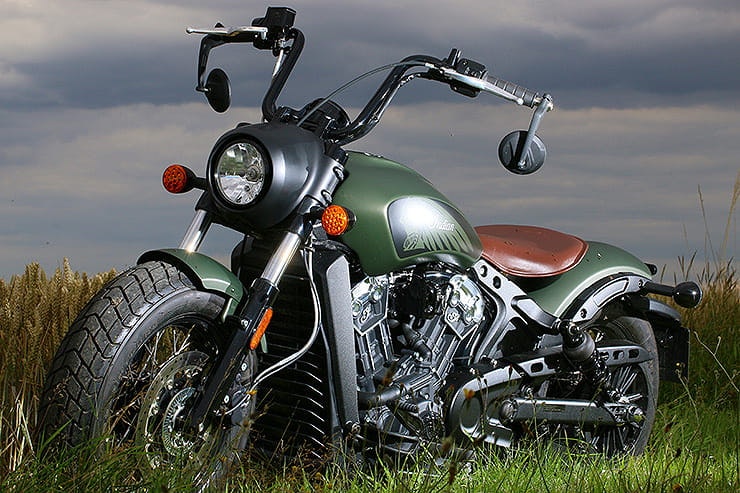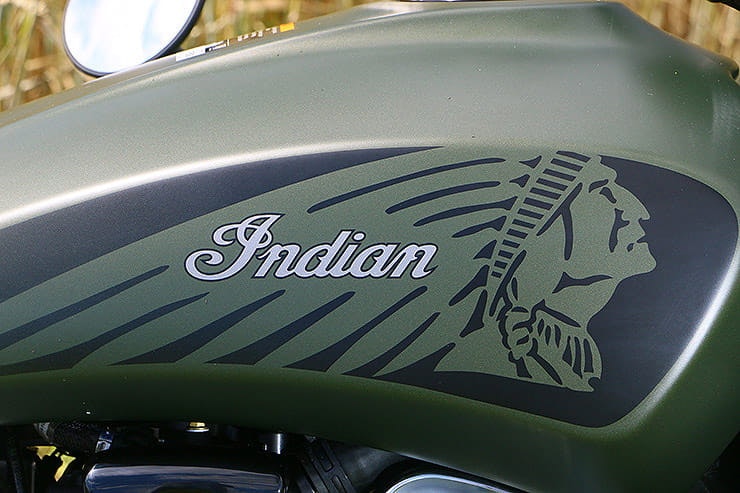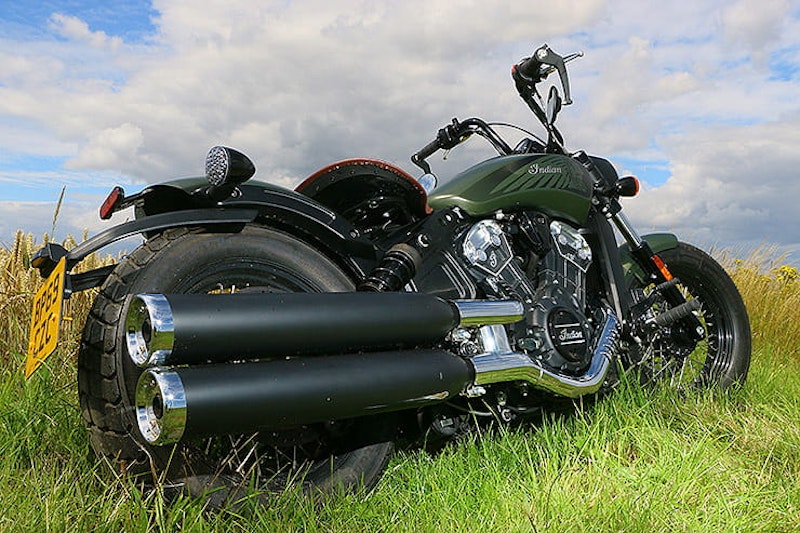Indian Scout Bobber Twenty (2020) - Review
BikeSocial Road Tester
29.10.2020
Overview
In the 1960s, Kiwi Burt Munro used a self-modified 1920 Indian Scout engine to famously set several land speed records at Bonneville salt flats. Rest assured this Scout is not Burt’s Scout – The World’s Fastest Indian, the Bobber Twenty ain’t.
But if you’ve reached a point in your riding career at which you’re looking for a new experience – done the sportsbikes thing, had a few adventure bikes, fancy something leftfield – then you might want to take a machine like the 2020 Indian Scout Bobber Twenty for a test spin.
Because the Scout Bobber Twenty’s brand of low-slung, street rod-style, ape-hanger, feet-forward cruiser is a niche of a niche of a niche. The Twenty the result of turning a standard Indian Scout into a Bobber with a few choice components, then turning a Bobber into a Bobber Twenty with a few more.
To put it simply, the differences between a Scout, Scout Bobber and Scout Bobber Twenty are based around riding position and styling – with ape-hanger bars and a flying seat foremost among the items that distinguish a Twenty from a standard Bobber, the riding position is the only tangible dynamic change between the models. Engine and chassis are common across all Scouts.
So what can you expect from riding a Scout Bobber Twenty? Let’s find out...
Cool as a chilled beer on a late summer evening
Good finish and attention to detail
Great combination of power and civility
Surprisingly convenient (if not exactly practical)
Surprisingly good riding position
VERY limited ground clearance
Bone-jarring rear suspension
Did I mention the ride quality?
Indian is a manufacturer who flies well below the mainstream UK motorcycling radar. Most of us, perhaps, know a bit of Indian history; we might know Indian vied with Harley-Davidson as the go-to pre-Great War American motorcycle manufacturer, producing a stream of successful board- and dirt track race bikes and briefly becoming the world’s largest motorcycle company. It’s less well known Indian also entered the 1911 TT – the first to be held on the existing Mountain course – and took the top three places in the Senior race, first time out (blimey, who wouldn’t loved to have seen that?). Indians were occasionally raced at the TT either side of the First World War – but, after the mid-1920s, they left and never returned.
Indian were successful at home in the USA between the wars, with new models, including the Scout – but after having moved production to a war footing and building bikes primarily for British and Commonwealth forces in the Second World War, the company struggled through the 1940s. Their bikes weren’t as popular as Harleys either with American servicemen or, it seemed, the American public. In 1953, Indian went bust.
And that was it for a long while, until – after a few well-intentioned but doomed attempts to re-launch the company in the 1990s – US snowmobile and ATV manufacturer Polaris, already building the Victory range of cruisers, customs and grand tourers, acquired the name.
Polaris ploughed cash and development into the Indian brand – and the result, in 2013, was the Chieftain: a Harley-esque grand tourer with a grunt-laden 1811cc 49° air-cooled pushrod V-twin making a claimed 87bhp and at least a million torques (118 lb.ft, to be precise).
In 2015, as Polaris were winding down production of the Victory machines, they launched the Indian Scout; a bike not in any way connected to Burt Munro’s land-speed record-setting 1960’s re-vamp of the 1920’s design, but a cruiser. Of course. Still had a V-twin though; an 1133cc liquid-cooled dohc 60° V making around 100bhp and 72 lb.ft delivered through a six speed gearbox with belt final drive, and hanging from an aluminium frame.
And that’s essentially the bike we’re dealing with here, give or take some styling and riding position tweaks. The Bobber Twenty is a Scout with shorty mudguards, single ‘flying’ seat, headlight nacelle, ape hanger bars, wire wheels and classy paint scheme and Indian ‘face’ logo on the tank.
It must be said, it’s a classy looking bike.
VIDEO REVIEW: Indian Scout Bobber Twenty (2020)
We hand the keys over to our regular test pilot, Simon Hargreaves, for his thoughts after some Lincolnshire laps on the new Indian
2020 Indian Scout Bobber Twenty price
The standard Bobber is £11,899, rising £100 to £11,999 for the Scout Bobber and up another £900 for the Scout Bobber Twenty to £12,899. That’s a bit more than a Harley Street Bob, at £12,295.
Power and torque
The Scout Bobber Twenty is claimed to make 100bhp at an undisclosed rpm, and 72 ft.lb of torque at 5600rpm (or 6000rpm if you read the US website – maybe their revs are different to our revs).
Inside, it’s a modern engine and entirely disconnected from its pre-war namesake – in the sense there’s no attempt to engineer-in a faux ‘heritage’ connection to the past. The 60° V layout is probably best remembered for the Rotax-designed and built Aprilia RSV Mille engine. At 998cc, that motor had a 97mm bore and 67.5mm stroke – a bore/stroke ratio of 1.44. It was a sportsbike. The 1133cc Scout motor dimensions are 99mm bore and 73.6mm stroke: a 1.35 bore/stroke ratio, which is still plenty oversquare for a cruiser engine (for comparison, the Harley Street Bob – a much bigger engine at 1746cc, is undersquare – 100mm x 111mm, or 0.9 bore/stroke).
This means the fundamental architecture of the Indian motor isn’t all about low rpm teeth rattling torque and power be damned; the engine designers have aimed for a more contemporary power curve; linear, smooth, and evenly spread across the revs rather than a torque curve that rises like a mountain from tick over and drops off a cliff shortly afterwards.
Modernity is also evident in the Scout’s valvetrain: not a pushrod tube or air-cooling fin in sight. Liquid-cooling, double overhead cams, narrow valve angles, four-valve heads and wide throttle bodies speak of focus on gas flow, using every tool in modern engine design to create a flexible motor rather than a one-trick cruiser pony. This is an engine spec and power curve that wouldn’t look out of place in an adventure bike skirt or a conventional roadster chassis.
Engine, gearbox and exhaust
And so here’s the first surprise the Indian has up its sleeve; the engine is sweet. Its performance is ideally suited to its riding position; some bikes with feet-forward arrangement (I’m thinking so-called Power Cruisers) can sometimes be frustrating because they come over-endowed with a gargantuan engine and titanic performance completely at odds with their footpeg, seat and handlebar layout. So if you actually use a significant proportion of the motor’s potential, your neck, wrists and thighs take such a battering from resistance to an unyielding torrent of motive force, you’re forced to slow down. Which negates the point of having a monster engine in the first place.
Which is why it’s a relief, literally, to discover the Scout Bobber Twenty’s performance isn’t neck-snapping, wrist breaking or likely to stretch your fingers into thin, Plasticine spaghetti. It’s in the Goldilocks zone for a cruiser – not too little nor too much; it’s just right.
With clean and precise fuelling (no trace of snatch), the V-twin gargles when you crack open the taps, then digs in and pulls any gear from a mere drop of revs. There’s no chugging, no drivetrain lash – just a smooth, pulsating flood spreading out across the rev range like a duvet, with a single engine balancer negating nasty vibes but letting some of the natural lumpiness through for effect. But anyone hoping for a raucous blunderbuss of bad behaviour or a time-travelling 1950’s spud gun should look elsewhere; the Bobber Twenty is a model of modern civility. It’s not the loudest motor in the world, mechanically or at the exhaust, and it won’t rattle your teeth.
But don’t mistake good manners for sluggishness; the 1133cc motor is fit and perky, punting through gears (not a bad box for an American cruiser – clutch is light and the shift is accurate, if a bit clunky) and loading up the belt final drive with an almost Japanese engine’s civility. The V wouldn’t be out of place in a more conventional chassis; it’d make a great all-rounder power plant.
2020 Indian Scout Bobber Twenty Economy
With 12.5 litres in the tank, the Scout hasn’t got a touring range; with consumption averaging 41mpg (Imperial, not US), the Scout needs a splash every 100 miles or so. Like any bike with a 60mm throttle body diameter, that figure can drop with heavy-handed use.
Handling, suspension, chassis and weight
The Bobber is a cruiser and while its motor might sacrifice nothing for function over style (which is a bit unfair; the Scout’s engine is one of the best-looking, unashamedly liquid-cooled motors out there), the Scout’s chassis certainly does. An aluminium frame ticks the 21st century box and the unadjustable rwu tele forks are fine, probably, with their 120mm travel – it’s actually hard to judge their performance because all you can feel is every bump and ripple fed into your bum by a pair of 51mm rear shocks. So much so, riding the Scout makes you realise why they’re called ‘shocks’.
It’s hard to criticise the bike for a hard ride; it’s a Bobber, it’s supposed to have a hard-tail look, and if you want the back end to run low to the ground, something’s got to get shorter, right?
But it doesn’t have to be that way; Harley’s Cruiser range (including the Street Bob) hide their rear suspension with a monoshock and manage to get a slightly better 86mm of travel from it. Triumph’s Bobber goes one better and manages to cram a rising rate linkage onto the bottom of the shock, making the most of its 77mm travel. So it’s possible to have your style cake and eat it; Indian just need to try a bit harder. No, not that kind of harder.
The Scout Bobber isn’t a hard bike to manage, either. The seat height is a mere 695mm (which must be a misprint; it feels as if it’s half that), and while 259kg fully fuelled isn’t exactly light, the bike is well-balanced even pushing it around on gravel – where it feels as if it could rest on its pegs if it toppled over. In fact the biggest problem managing the bike in a car park is clipping your ankles on them. I even managed to clip them on a kerb going round a corner, which was momentarily sub-optimal.
The pegs spend a lot of time in contact with the ground anyway; clearance is comically restricted. Again, it comes with the territory; what’s important is nothing important grounds out – the pegs have plenty of girth to grind through before you get to the soft bits.
Peg dragging and bum-bashing aside, the Scout’s steering is surprisingly light and accurate – rake and trail figures aren’t absurd and the wheelbase is kept in check by the compact nature of the engine’s 60° V-angle. A pair of Pirelli MT 60 RS tyres on 16in wire wheels deliver that fat, knobbly street look – the front and rear rims are the same size; the front has a 130/90 and the rear squeezes a 150/80 on. They’re so similar you could probably swap them over and not notice.
Comfort over distance and touring
Oddly enough, the Scout’s harsh ride doesn’t actually spoil the ride. It kinda is what it is – and as you slope off down the road, sat low, arms flung at the high bars and spine slumped into the surprisingly accommodating flying seat, feet groping for the pegs... it’s cool, padding along on your average UK high street, in exactly the same way a Harley often isn’t. It’s hard to quantify (which means it’s just my opinion) but there’s still something faintly cheesy about most Harley Cruisers (Fat Bob gets a free pass here; it’s a total monster). There’s either too much chrome, too much fork angle, the bars are too high or too low, pegs too far back or too far forward, front wheel too skinny etc. The Scout Bobber 20 is a good balance of blacked-out understatement versus look-at-my-flying-seat; and it doesn’t over-do the heritage thing (even if the name is culturally inappropriate in polite society). It looks good because it looks good, not because it’s shouting at someone else to notice it.
Whether you’d say the same after a couple of hundred miles is another matter; the position isn’t immediately odd or tiring and a steady 70mph is about the comfortable limit of wind blast. A couple of 80-100 mile round trips in fine weather on twisty country roads were huge fun. London to Edinburgh would be another matter entirely.
Rider aids and extra equipment / accessories
The Scout Bobber 20 comes with... a USB port – which is actually pretty useful. ABS is mandatory – the single two-pot sliding caliper up front is fine – and there’s no traction or other rider aids.
The Scout’s bar-end mirrors can be slung under the bars, which renders them useless, but are easily reversed (left to right, not back to front) so they sit on top of the bars instead. Don’t look as good, but work much better.
Rivals
To find a rival for the Indian Scout Bobber 20, it’s probably wise to start looking at bikes with ‘Bobber’ in their titles. Moto Guzzi’s V9 Bobber is cheaper, at £9000, but it’s smaller, lighter and shorter, with an 853cc V-twin making 55bhp and 46 lb.ft; substantially less then the Indian.
If you fancy something bespoke and seriously left-field, try CCM’s Spitfire Bobber – for £10 grand you get their 55bhp 600cc single in a steel tube trellis frame; funky, but it’s hardly your classic cruiser styling.
Triumph’s Bonneville Bobber is cheaper – £10,650 – and with its fake air-cooling and heritage styling, it looks more authentic from a distance. It’s also put together with Triumph’s fairly breath-taking quality of finish. The Bobber Black comes with higher-spec suspension and brakes for an extra grand. The Triumph’s 1200cc parallel twins are bigger than the Scout’s 1133cc, but make less power – 77bhp – and more torque – 78 lb.ft. They’re also lighter and have better ride quality and road manners than the Indian.
And then there are the Harley Cruisers, and something like the £12,295 Street Bob or £14,295 Fat Bob – the Scout sits between the two with its combination of brutal modernity and classic trim. Neither of the Harleys have the Bobber 20’s flying seat, which may or may not be a stylistic deal breaker. The Street Bob is a little more traditional, with higher bars and fork gaiters, while the Fat Bob is all grunty sci-fi. And with 1868cc and 114 lb.ft, blimey it bangs a bit...
2020 Indian Scout Bobber Twenty verdict
It’s hard to critique bikes like the Indian Scout Bobber 20 because they’re not bought with a keen eye on things we can easily measure – it’s not about tank range, speed, horsepower, or even comfort, particularly. It’s nice to have all those things, and the Scout Bobber 20 does some of them well, some with a degree of compromise. The engine is a nice balance of civility, charisma and performance – and it meets our expectations of rideability: the brakes work, the clutch is light, the fuelling good, and the gearbox isn’t borrowed from a tractor – having said that, modern tractors are spectacular so we’d better leave that cliché aside. And they’ve definitely got better ride quality than the Scout.
But much more, the Scout is about style and looks, and how it makes you feel as much when it’s parked up at a cafe or in a drive than when you’re actually riding it. And on that level, it’s a winner.
2020 Indian Scout Bobber Twenty spec
Looking for motorcycle insurance? Get a quote for this motorbike with Bennetts bike insurance
What is MCIA Secured?
MCIA Secured gives bike buyers the chance to see just how much work a manufacturer has put into making their new investment as resistant to theft as possible.
As we all know, the more security you use, the less chance there is of your bike being stolen. In fact, based on research by Bennetts, using a disc lock makes your machine three times less likely to be stolen, while heavy duty kit can make it less likely to be stolen than a car. For reviews of the best security products, click here.
MCIA Secured gives motorcycles a rating out of five stars, based on the following being fitted to a new bike as standard:
A steering lock that meets the UNECE 62 standard
An ignition immobiliser system
A vehicle marking system
An alarm system
A vehicle tracking system with subscription
The higher the star rating, the better the security, so always ask your dealer what rating your bike has and compare it to other machines on your shortlist.



